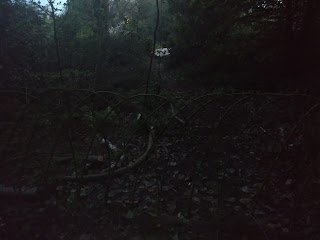After a long winter, the first sign I noticed that the seasons were changing was the regularity with which I was awoken at unsociable hours by the dawn chorus in the trees outside my window, loud enough to break through my sleep and punctuate my dreams, before finally waking me fully.
The rhythm and routine of bird call as part of city life, and the way in which it might coexist with or be altered by birds’ close proximity to humans in urban environments, is something that interests artist Rae Story.
She has spent nearly a year working with Manchester arts group St Luke’s on a participatory project mapping the quiet spaces of the city; one of her long-held ambitions has been to bring people together to listen to a dawn chorus in a publicly accessible green space.
An appropriate park or garden in which to gather participants safely and discreetly in the depths of night eluded her – until she was introduced to the Parrs Wood Environmental Centre, a hidden green space on the edges of Didsbury. Situated on the southern outskirts of Manchester, where the city meets the River Mersey on the boundary of Cheshire, the site could easily be missed. Although it forms part of a ‘green corridor’ of woodland and riverside paths that provide a pleasant off-road walking and cycling route between Stockport and south Manchester’s suburbs, the entrance is sandwiched between the nondescript architecture of a chain hotel and a huge multi-use leisure complex of the type that often characterise busy arterial routes.
Parrs Wood Environmental Centre has a long history as an educational outdoor space for the city’s children. Founded in the years immediately following the Second World War, and run for many years by the city council, school classes were given their own plots to tend. The site also provided adult education through the Workers’ Educational Association.
Initially part of a country estate, with the former stables, walled kitchen garden and gardener’s cottage still in evidence, the centre is now part of Parrs Wood High School, but continues to offer adults and children environmental education under the guidance of volunteers.
On International Dawn Chorus Day, fifteen of us meet shortly before 4am under a bright lopsided, yellow-tinged moon, sitting low in the sky. Although it’s been a balmy day the grass is sodden with dew; my summer plimsolls are quickly soaked through.
We’re led through an overgrown path in the woods to a clearing encircled by overturned logs which double as benches, and invited to forget everything else for the next forty minutes in order to focus fully on what we hear in the air surrounding us.
As the birds call from all sides, under a densely curtained canopy of leaves, it feels like we’re experiencing theatre in the round, in some kind of natural performance tent, the performers unseen. As time goes by, birds enter and leave, and come back; the low-toned call of the wood pigeon is a late entry against a patter of higher pitched trills. Although, we hear the occasional car on the road outside and the rumble of a lone night train, this is the birds’ space and time. Two sirens go past, shifting in and out of the chorus, which continues regardless.
I’m listening intently, in a way I’m not used to. My sense of smell becomes more acute, too; there’s a definite aroma of the warm, earthy smell of horses and, later, the sweet scent of crabapple blossom. It slowly grows lighter; perhaps our senses are adjusting, too.
What I feel most acutely, though, is my own illiteracy when it comes to knowledge of birds or the natural world. I can’t even find the words to describe the calls I’ve heard, in order to ask which birds they might belong to.
Mapping Manchester’s Quiet Spaces is a project by the artist Rae Story with St Luke’s Arts Project. A celebration event, with presentations from the workshops, will be held at Elizabeth Gaskell’s House on Tuesday 26 June at 3pm and 6pm. For more information about this and other events visit www.mappingmanchestersquietspaces.org.
Sunday, 6 May 2018
Listening to the city: Mapping Manchester’s Quiet Spaces on International Dawn Chorus Day
Labels:
Art,
cities,
Didsbury,
education,
History,
Manchester,
Music,
nature,
Public art,
Rae Story,
River Mersey,
rivers,
social history,
Sound,
Sound art,
Stockport,
twentieth century,
Walking
Subscribe to:
Post Comments (Atom)













No comments:
Post a Comment